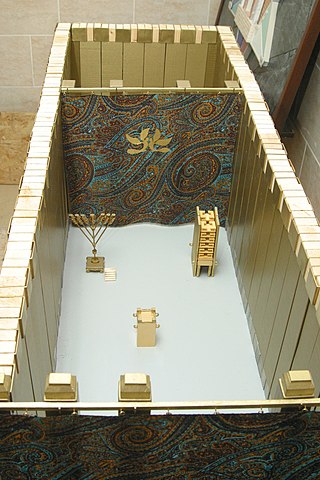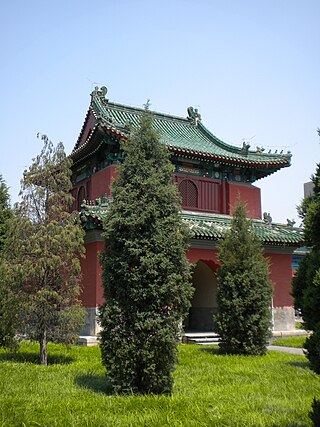Altar of Heaven may refer to:
- Ara Coeli, legendary ancient altar on the Capitoline Hill in Rome
- Temple of Heaven, Ming temple complex in Beijing
Altar of Heaven may refer to:

The Temple in Jerusalem, or alternatively the Holy Temple, refers to the two religious structures that served as the central places of worship for Israelites and Jews on the modern-day Temple Mount in the Old City of Jerusalem. According to the Hebrew Bible, the First Temple was built in the 10th century BCE, during the reign of Solomon over the United Kingdom of Israel. It stood until c. 587 BCE, when it was destroyed during the Babylonian siege of Jerusalem. Almost a century later, the First Temple was replaced by the Second Temple, which was built after the Neo-Babylonian Empire was conquered by the Achaemenid Persian Empire. While the Second Temple stood for a longer period of time than the First Temple, it was likewise destroyed during the Roman siege of Jerusalem in 70 CE.
The Unknown God or Agnostos Theos is a theory by Eduard Norden first published in 1913 that proposes, based on the Christian Apostle Paul's Areopagus speech in Acts 17:23, that in addition to the twelve main gods and the innumerable lesser deities, ancient Greeks worshipped a deity they called "Agnostos Theos"; that is: "Unknown God", which Norden called "Un-Greek". In Athens, there was a temple specifically dedicated to that god and very often Athenians would swear "in the name of the Unknown God". Apollodorus, Philostratus and Pausanias wrote about the Unknown God as well.

An altar is a table or platform for the presentation of religious offerings, for sacrifices, or for other ritualistic purposes. Altars are found at shrines, temples, churches, and other places of worship. They are used particularly in paganism, Christianity, Buddhism, Hinduism, Judaism, modern paganism, and in certain Islamic communities around Caucasia and Asia Minor. Many historical-medieval faiths also made use of them, including the Roman, Greek, and Norse religions.

The Temple of Heaven is a complex of imperial religious buildings situated in the southeastern part of central Beijing. The complex was visited by the Emperors of the Ming and Qing dynasties for annual ceremonies of prayer to Heaven for a good harvest. The Temple of Heaven was inscribed as a World Heritage site in 1998 and was described as "a masterpiece of architecture and landscape design which simply and graphically illustrates a cosmogony of great importance for the evolution of one of the world's great civilizations..." as the "symbolic layout and design of the Temple of Heaven had a profound influence on architecture and planning in the Far East over many centuries."
In Eastern Christianity, an iconostasis is a wall of icons and religious paintings, separating the nave from the sanctuary in a church. Iconostasis also refers to a portable icon stand that can be placed anywhere within a church. The iconostasis evolved from the Byzantine templon, a process complete by the 15th century.

The Holy of Holies is a term in the Hebrew Bible that refers to the inner sanctuary of the Tabernacle, where God's presence appeared. According to Hebrew tradition, the area was defined by four pillars that held up the veil of the covering, under which the Ark of the Covenant was held above the floor. According to the Hebrew scripture, the Ark contained the Ten Commandments, which were given by God to Moses on Mount Sinai. The Temple in Jerusalem was said to have been built by King Solomon for keeping the Ark.

The Ritan is a public park located in Chaoyang District, Beijing, China. It is within the Jianguomen area. The nearest Beijing Subway station is Yong'anli on the Beijing subway Line 1. The park was initially home to the Temple of the Sun, an altar built in 1530 during the late Ming Dynasty.
Wed is a pre-Islamic Arabian god. it was the national god of the Minaeans of South Arabia, Yemen, and the snake was associated with it. It is also called Waad and Wadum.

The Basilica of Saint Mary of the Altar in Heaven is a titular basilica in Rome, located on the highest summit of the Campidoglio. It is still the designated church of the city council of Rome, which uses the ancient title of Senatus Populusque Romanus. The present cardinal priest of the Titulus Sanctae Mariae de Aracoeli is Salvatore De Giorgi.

Yuanshi Tianzun, the Celestial Venerable of the Primordial Beginning or the Primeval Lord of Heaven, is one of the highest deities of Taoism. He is one of the Three Pure Ones and is also known as the Jade Pure One. He resides in the Great Web or the Heaven of Jade Purity. It is believed that he came into being at the beginning of the universe as a result of the merging of pure breaths. He then created Heaven and Earth.

The Woes of the Pharisees are a series of criticisms by Jesus against scribes and Pharisees recorded in Luke 11:37–54 and Matthew 23:1–39. Mark 12:35–40 and Luke 20:45–47 also include warnings about scribes.
Religious use of incense has its origins in antiquity. The burned incense may be intended as a symbolic or sacrificial offering to various deities or spirits, or to serve as an aid in prayer.

The Temple of the Moon is an altar located in Fuchengmen, Xicheng District, in western Beijing, China. The altar was built in 1530 during the Ming Dynasty for use in ritual sacrifice to the Moon by the Emperor of China.

The Temple of the Earth in Beijing, China, is located in the northern part of central Beijing, around the Andingmen area and just outside Beijing's second ring road. It is also located just a few hundred yards north of Yonghe Temple. At 42.7 hectares, it is the second largest of the four Temples of Beijing behind only the Temple of Heaven.

Temple of Agriculture or Altar of Agriculture is a historic site in Xuanwu District of Beijing, China, and located near the Temple of Heaven.

Ad orientem, meaning "to the east" in Ecclesiastical Latin, is a phrase used to describe the eastward orientation of Christian prayer and Christian worship, comprising the preposition ad (toward) and oriens, participle of orior.

The Circular Mound Altar is an outdoor empty circular platform on three levels of marble stones, located in Beijing, China. It is part of the Temple of Heaven.

An ancestral shrine, hall or temple, also called lineage temple, is a temple dedicated to deified ancestors and progenitors of surname lineages or families in the Chinese tradition. Ancestral temples are closely linked to Confucian philosophy and culture and the emphasis that it places on filial piety.

The Esplanade of Sacrifice to the Heaven and Earth is an imperial altar situated south of the city of Huế, central Vietnam. It also known as the Nam Giao altar. It is dedicated to the heaven and earth. The complex was visited by the monarchs of the Nguyễn dynasty for annual ceremonies of prayer to Heaven.

According to the Bible, the Tribe of Levi is one of the tribes of Israel, traditionally descended from Levi, son of Jacob. The descendants of Aaron, who was the first High Priest of Israel, were designated as the priestly class, the Kohanim.